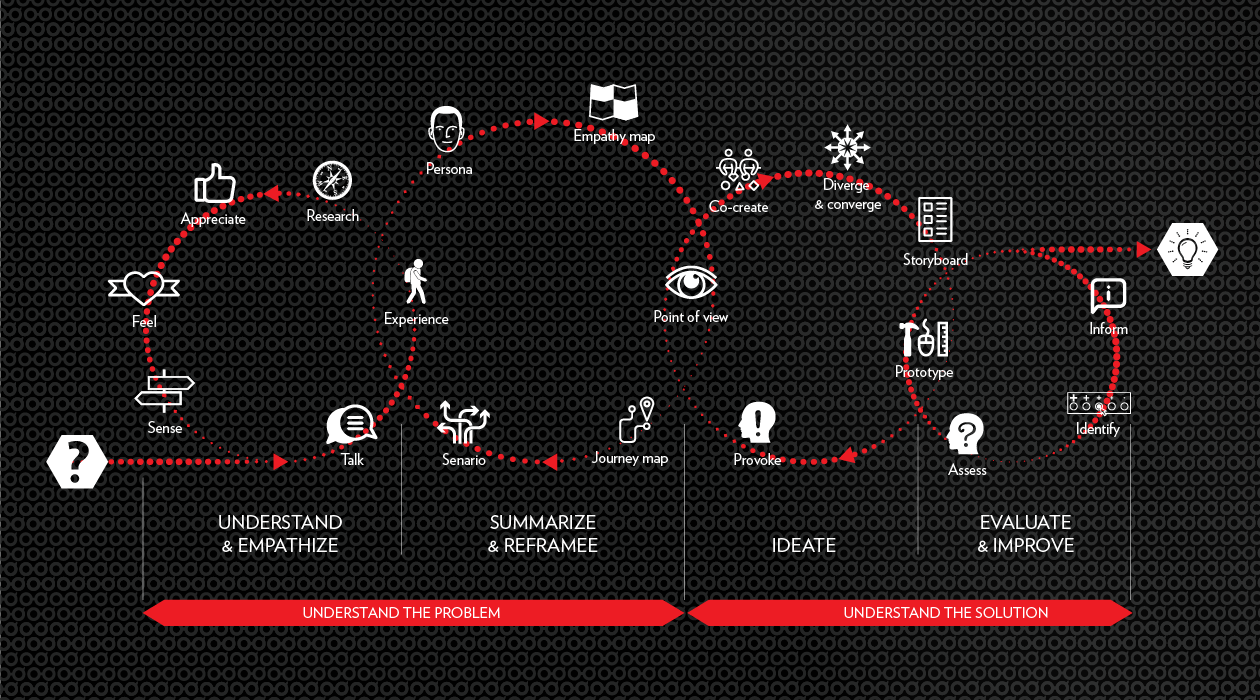Design Thinking is a hot topic and highly misunderstood. We often hear some form of the following sentiments.
- Design Thinking is something only Designers do
- Design Thinking is a controlled process with linear steps to yield a consistent outcome.
- Design Thinking is a silver bullet.
- Design Thinking is the same thing as Ideation, Creativity, Brainstorming.
Over the next two weeks, we will consider these statements in turn. Today we tackle the misconceptions about who does it and how it is accomplished.
Only by Designers. Design Thinking was inspired by designers for sure. The way in which the designers approach a problem is unique compared to what is typical in business. Designers first understand, question, explore the problem before honing in on solutions. They expand and diverge before converging. They accept the obstacles and embrace them, a very different way of coping with them than others in business. In business schools in the past, one was taught to identify a few options and pick the best one. In design thinking, you never accept the problem as stated, you expand it. From this, you might reframe the problem entirely and find there are countless solutions. You are just trying to pick a better one than the current option, knowing that things will evolve and change over time. This approach is very generative. Generative approaches are needed in many places, not just design, so it doesn’t have to live exclusively with designers. Yet, the other disciplines practicing it must not just adopt the idea of a generative process but the spirit and mindset as well. It is an emergent process and to engage in it any other way is to limit it.
Controlled, Linear Process, Consistent Outcomes. Design Thinking practitioners have often visualized the approach in 2 dimensions in a way that looks linear. In reality, the approach is more flow and cycle than linear as Herve’s typical process illuminates below. What you are doing at any part of Design Thinking informs and shapes what is needed next. While it has some basic components, Design Thinking is emergent. That means you can’t, nor should, control it tightly. It’s about discovery and that requires that you allow for serendipity. Imagine that, relying on serendipity, how very counter cultural! Well done, Design Thinking delivers valid insights and solutions, but it is different every time as you allow flow to guide you. This is where a lot of people more versed in traditional problem solving struggle. The “letting go so you can flow” is tough for them. They try to practice Design Thinking as if it were an engineering process with check boxes and sequences. But, it is a creative process with twists and turns…a bit of managed chaos. Very useful when done well and very predictable and average when not allowed this creative energy.
Another variant of the controlled process misunderstanding is that Design Thinking is a workshop. Yes, the 1-3 day workshop is popular and easy to access but truly Design Thinking is more than the offsite in a cool place. It is the work before to get grounded on the problem, observe stakeholders and conduct other inspiring research which helps frame and fuel the work. And, the creative session that follows is hard work and often has many iterations before complete. Ideas are born, but they must be nurtured and tested and analyzed for success/learning after a creative session. Design Thinking is all of these three phases (grounding/framing, creating, nurturing/testing). Together, they provide the opportunity to see the invisible connections between the insights, the solutions, the interactions, the learnings, the outcomes in general. In that sense, we can speak about a “process”. What is misleading is the notion of “process” stops at this point. The rest is radically different each time it is operated. It depends of the challenge, the organization, the competition, the business model, the vision & mission of the company or even the project sponsor to name a few. When applied seriously, Design Thinking is time consuming and requires lot of energy, involvement and customization. It is for this reason, that to do it well in organizations, you need a leader that supports the investment and the ambiguity and fluidity of the approach. At P&G, Design had A. G. Lafley, CEO, as sponsor supporting this work and so it flourished. Without him, perhaps the impact would have never been seen.
Stay tuned for next week’s post when we explore the last two misconceptions.
Cindy Tripp & Herve Collignon
Take Action
Consider the process as you have experienced it. Did it have the emergent quality of great Design Thinking? How might you have altered what you did to allow the process to reflect your challenge, situation and learning?



